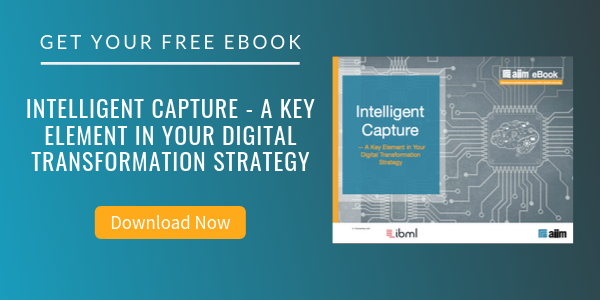
5 Ways to Use Intelligent Capture to Get All Those Chaotic Incoming Documents under Control
In this era of big data, what do we do with all of the exploding data coming into your organization?
First of all, you need to digitize it. you need to get it in a way that it's usable, accessible, available. So, we have to digitize it. Now we've shifted our thinking away from scanning and toward intelligent capture. We need to capture more information and intelligently route it to accelerate the availability of that information to the knowledge workers who need it.
Here is one example from the healthcare space of how information volumes are growing. One trade journal recently said that every hour treating a patient in America creates at least 30 minutes of paperwork. This makes perfect sense—all those downstream users who need to be able to not only get the regulatory and treatment information but also the billing information and the prescription information to make sure that they can get that patient through the process.
Across multiple industries, capture requirements are not only becoming larger, they're also becoming more complex. It's not picture taking anymore. It's not just capturing header information from an invoice. Organizations are asking, “Why aren't we capturing all the line item detail on that invoice so that we can make smarter business decisions about what's happening with our purchasing?" Organizations are not only capturing more documents, but more information from each document than ever before.
The reality for most organizations is that they can't keep up with these demands. Their antiquated information capture systems are getting in the way.
In a typical organization, information might be coming into you from customers, field workers, folks in branch or remote offices, as well as your mailroom. And you know what? That information is coming in as paper, via email, via fax, maybe a website, or maybe a mobile device. It might be coming from a mobile location, maybe a BPO provider you have in a specific region, maybe from your own shared services center.
What happens is that organizations are not set up to manage that information as it flows through those back-end processes to the systems and processes of record and to the knowledge workers who need it. Think about financial processes. Businesses are spending millions of dollars to purchase and millions of dollars to maintain ERP systems. They're the financial nerve center of the organization, and yet, what is in front of many ERP systems? Manual, semi-automated, antiquated, paper-based financial processes that make it difficult to get information into these ERP systems.
What happens when you fail to automation the “information ingestion” process? It results in high labor costs. It results in poor business agility. You can't see the information that's coming into your organization. You are forever stuck in a reactive mode to customer service trends and to sales trends. You get more customer complaints because you can't see problems in your supply chain until it's too late. You have a slow inventory turn and higher day sales outstanding. If you're in a financial environment, you're end up with late payments, penalties, fines, security breaches, and compliance violations. If only we could get a handle on our content, we can avoid all of this.
The challenge organizations face when they're receiving documents via multiple delivery channels is that while paper was clearly not the right way to be capturing documents, now that we have this diversification of delivery channels, organizations have not figured out how to normalize the handling of those documents across those delivery channels. If you're sitting on an antiquated scanning or capture solution, you're in a really bad position to solve that problem.
What you need is intelligent technology that allows you to ingest documents via in any delivery channel in any format, paper or electronic, to extract the information you need, then to classify the documents to determine which documents are which to eliminate all that manual and post-document sorting. And that also allows you to align the information with what you might have already stored in downstream systems of records, to validate that the information you captured is correct and that the document being processed is the one you're expecting. Then finally, to connect all of this to any downstream systems or processes.
Here are the five steps you need to consider in order to get your multi-channel inputs under control:
-
Ingestion. It all starts with ingestion. Today the reality is that organizations are ingesting paper and electronic documents via a number of methods, and all of these are necessary for the typical environment. You need to expect to receive documents via a number of delivery channels.
-
Extraction. Next, you need to be able to extract information, and it's not just optical character recognition. You need to be able to use a number of extraction techniques to get the full amount of information you need for your business processes.
-
Classification. Once you have that information, you can then apply business rules that allow you to determine what type of documents you have and how it should flow in your organization. That extraction also helps you classify documents.
-
Validation. Once you've extracted that data, you need to make sure it's correct. You need to make sure that it aligns correctly with the information that we have stored in a downstream system.
-
Connection. Finally, we need to connect that information, all of that content, to those downstream user systems and processes that need it to drive the business. All of this together accelerates the access to information by those knowledge workers.
About John Mancini
John Mancini is the President of Content Results, LLC and the Past President of AIIM. He is a well-known author, speaker, and advisor on information management, digital transformation and intelligent automation. John is a frequent keynote speaker and author of more than 30 eBooks on a variety of topics. He can be found on Twitter, LinkedIn and Facebook as jmancini77. Recent keynote topics include: The Stairway to Digital Transformation Navigating Disruptive Waters — 4 Things You Need to Know to Build Your Digital Transformation Strategy Getting Ahead of the Digital Transformation Curve Viewing Information Management Through a New Lens Digital Disruption: 6 Strategies to Avoid Being “Blockbustered” Specialties: Keynote speaker and writer on AI, RPA, intelligent Information Management, Intelligent Automation and Digital Transformation. Consensus-building with Boards to create strategic focus, action, and accountability. Extensive public speaking and public relations work Conversant and experienced in major technology issues and trends. Expert on inbound and content marketing, particularly in an association environment and on the Hubspot platform. John is a Phi Beta Kappa graduate of the College of William and Mary, and holds an M.A. in Public Policy from the Woodrow Wilson School at Princeton University.



